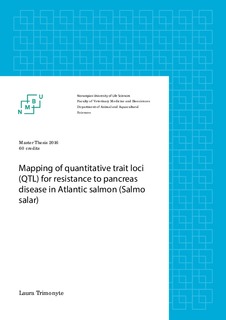| dc.description.abstract | Pancreas disease (PD) is an emergent disease which causes large economical losses to Atlantic salmon industry and severely affects welfare of fish. Two different subtypes of the PD virus, SAV2 and SAV3, affect Atlantic salmon in Norway. Even subtype SAV2 don’t produce high mortalities, affected individuals reduce their growth and are left with lesions which affect carcass quality. Currently only between-family selection is applied to this trait, which reduces accuracy and selection intensity for resistance to PD. Methods of marker assisted selection (MAS) would improve results of genetic selection of resistance to PD as within family selection would be possible. The aim of this study was to detect linkage of single nucleotide polymorphism (SNPs) with QTLs related to resistance to PD. Fry of Atlantic salmon, from crosses of three unrelated populations, were challenged with SAV2 in fresh water and mortalities were recorded during the test period. In addition, tissue samples were collected from a subset of individuals in the test and genotyped using a custom 57K SNP array. Fry in the test were assigned to possible family groups using estimates of genomic identity by descent (IBD) relationship calculated from SNP data. Heritability of survival to PD, analyzed as a binary trait, was estimated from genotyped individuals using a genomic relationship matrix constructed by two methods. Both methods resulted in similar values, revealing a moderate heritability (h2 ~ 0.2). Genome wide association analysis (GWAS) from genotyped individuals revealed twenty-six putative QTLs. Four of the putative QTLs explained on average 10.9% of the genetic variance (~ 2.5% of the phenotypic variance). Genes related to immune response, metabolism and brain damage (in humans) were found in the area of chromosome twenty-one where the QTL was found. Twenty-two of the significant SNPs were classified as “lonely significant markers” as no SNPs in the neighbor region show association with the trait. In addition, because of the large number of duplicated areas in the Atlantic salmon genome, the exact location in the genome of “lonely significant markers” was put on doubt, leading us to not consider them suitable for MAS. Because of the limited amount of variance explained by the putative QTLs and the uncertainty of the value of the twenty-two “lonely significant markers”, the benefit of MAS may be limited. Genomic selection may be more effective tool to increase accuracy and genetic gain in resistance to PD. | |

